
The Moglietti sanctuary (Italian: Santuario dei Moglietti) is a sanctuary devoted to Our Lady of Graces in the comune of Coggiola. [1]

The Moglietti sanctuary (Italian: Santuario dei Moglietti) is a sanctuary devoted to Our Lady of Graces in the comune of Coggiola. [1]
The sanctuary was built from 1888 enlarging an ancient chapel dating back to the 18th century.
The site once was a wetland and the name Moglietti (from the local expression muijeit, swamp) remembers the past ambient. The place is also known as the battlefield because, according to the local tradition, there has been a battle between the citizen of Coggiola and Fra Dolcino and his fellows. [2]
Today the sanctuary is composed by a small church, with apse, portico, belltower, and a small hostel. The ancient votive column with the fresco of the Virgin Mary with baby Jesus is still preserved in the church. [3] In front of the sanctuary there is the characteristic fountain that can be found in every sanctuary in the Biellese territory. [2]
Inside the church are exposed the many Ex voto donated by the devotees.
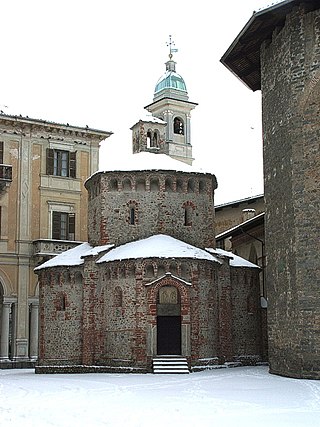
Biella is a city and comune (municipality) in the northern Italian region of Piedmont, the capital of the province of the same name, with a population of 44,324 as of 31 December 2017. It is located about 80 kilometres northeast of Turin and at about the same distance west-northwest of Milan.
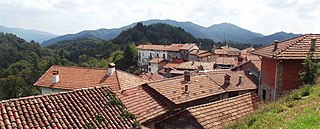
Ailoche is a comune (municipality) in the Province of Biella in the Italian region Piedmont, located about 70 kilometres (43 mi) northeast of Turin and about 14 kilometres (9 mi) northwest of Biella.
Strona is a comune (municipality) in the Province of Biella in the Italian region Piedmont, located about 70 kilometres (43 mi) northeast of Turin and about 12 kilometres (7 mi) northeast of Biella. As of 31 December 2004, it had a population of 1,217 and an area of 3.8 square kilometres (1.5 sq mi).

The Diocese of Biella is a Roman Catholic ecclesiastical territory in northern Italy, in the Piedmont region. The diocese was established in 1772. It is a suffragan of the Archdiocese of Vercelli. Biella is a city in Piedmont, 42km northwest of Vercelli.

The Biellese Alps are a sub-range of the Pennine Alps located between Piemonte and Aosta Valley (Italy).

Punta Tre Vescovi is a peak in the Biellese Prealps, in northern Italy. On its top, three valleys meet: Lys Valley, Valsesia, and Valle Cervo.

Antonio del Massaro da Viterbo, or Antonio da Viterbo, nicknamed il Pastura was an Italian painter.
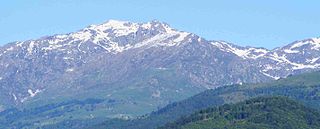
Colma di Mombarone is a mountain of the Biellese Alps, a sub-range of Pennine Alps, in northern Italy. It visually marks, along with Monte Gregorio on the opposite side, the entrance of Aosta Valley from the Po plain. On its top in 1900 was built a huge statue, still located there, of Jesus Christ.

Monte Barone is a mountain of the Alpi Biellesi, a sub-range of the Pennine Alps. Due to its isolation it offers a noteworthy point of view towards the Po plain and can be seen from quite a long distance away.

The Strona di Mosso is a 23-kilometre (14 mi) long creek in the Piedmont region of northwest Italy.

The Strona di Postua is a 14.1 kilometres (8.8 mi) long torrent in the Piedmont region of northwestern Italy.
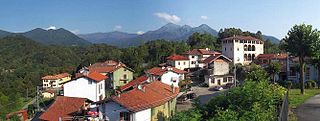
Flecchia is a frazione of the municipality of Pray, in Piedmont, northern Italy.
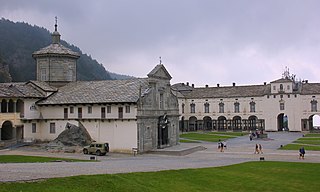
The Sanctuary of Oropa is a group of Roman Catholic buildings and structures in Oropa, frazione of the municipality of Biella, Italy. It is located at a height of 1,159 metres in a small valley of the Alpi Biellesi.

Monticello Amiata is a village in Tuscany, central Italy, administratively a frazione of the comune of Cinigiano, province of Grosseto. At the time of the 2001 census its population amounted to 425.
Cassa di Risparmio is the Italian word for savings bank, and may refer to:
The Path of Saint-Charles is an historical, artistic and devotional route which follows the travels of saint Charles Borromeo from Arona, his native town, and Viverone, where the path joins the Via Francigena.
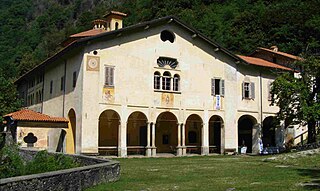
The Cavallero sanctuary devoted to Saint Mary of the Snow. It is set at 543 m height near the Sessera river in the municipality of Coggiola.

The Monte I Gemelli is an Alpine mountain located between Aosta Valley and Piedmont.

Zumaglia Castle is a medieval castle located at the top of Brich di Zumaglia on the borders of the communes of Zumaglia and Ronco Biellese in the Province of Biella.
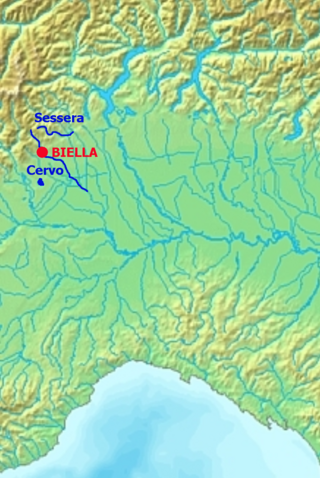
The hydrography of the Biella region, that is, the distribution of surface water in the province of Biella, Italy, falls almost entirely in the two basins of the Cervo and Sessera rivers, both tributaries of the Sesia. Some areas of the southwestern Biella region, on the other hand, are tributaries of the Dora Baltea; the largest natural body of water in the province, Lake Viverone, is also located in this area. In addition to the natural bodies of water, there are several irrigation canals in the plains built mainly to support rice cultivation and some reservoirs built in the foothills. In addition to irrigation, surface water is also used in the Biella area to serve the region's numerous industries and for potable water use, because the area is densely inhabited and groundwater capture is insufficient. Hydroelectric use, on the other hand, is very limited and is substantially confined to the Sessera Valley. The streams of the Biella region can be subject to ruinous floods as well, which have caused numerous damage to property and people over time.